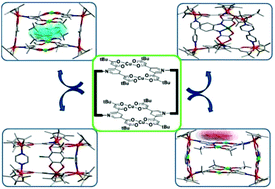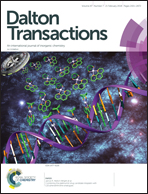Host–guest capability of a three-dimensional heterometallic macrocycle†
Abstract
A three-dimensional heterometallic coordination macrocycle is found to be capable of encapsulating planar pyrene (G1), coronene (G4) and non-planar corannulene (G2) guest molecules in high yields, giving rise to 1 : 1 host–guest complexes. The bowl-shaped guest corannulene is found to be significantly flattened upon inclusion within the cavity. However, macrocyclic compounds with larger cavity sizes, which form 1 : 1 stoichiometry assemblies with a naphthalene bisimide planar molecule (G3), are more inclined to form infinite sandwich structures. Furthermore, these heterometallic coordination macrocycles can be destroyed in the presence of a soft base to form hexanuclear triangular prism complexes. These structures are unambiguously revealed by single-crystal X-ray analysis.

- This article is part of the themed collection: Dalton Transactions Inorganic Symposia


 Please wait while we load your content...
Please wait while we load your content...